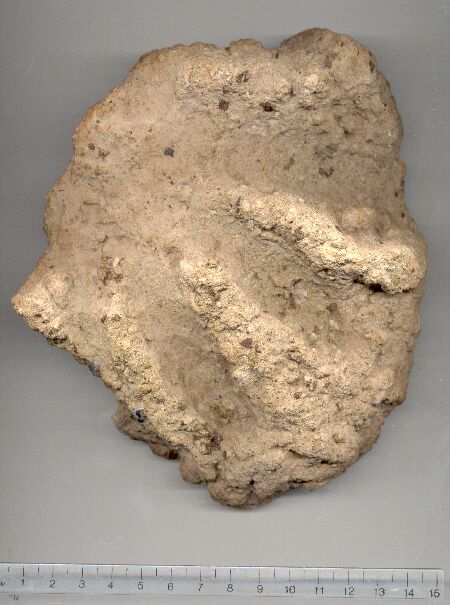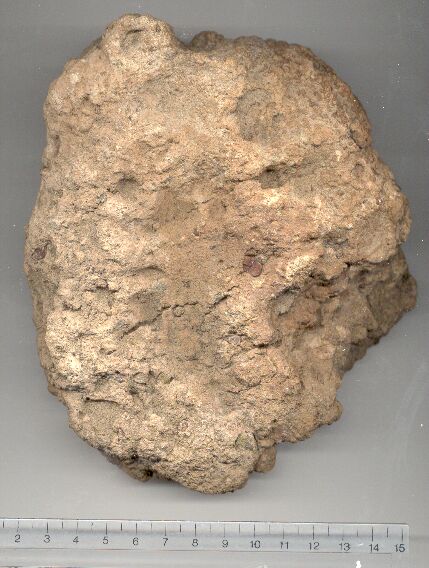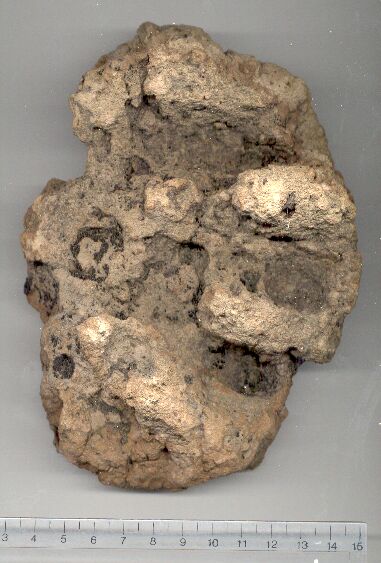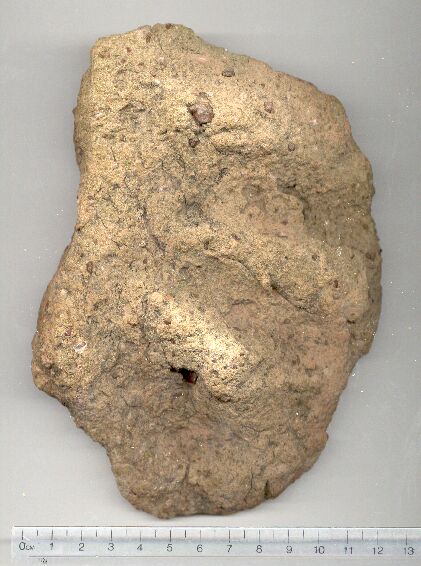Copper Mining and Smelting

Copper Mining and Smelting
The Al Ain chapter has collected considerable information and photographs regarding the copper smelting that took place in what was once known as Magan, now the Oman peninsula including the emirates of the United Arab Emirates and northern Oman.
The various sites include:
- this page, with images of bricks, copper ore and lists of related sites, including thumbnail descriptions of the sites
- images and locations of smelters at Khutwah
- images of what may be a copper ore roasting pit at Khutwah
- images of the results of testing ore samples
The ancient Sumerian literature refers to the land of Magan (or Makkan) as a source of copper. Several archaeological projects have been undertaken in Oman and the United Arab Emirates to document this industry that dates back 4000 years or more.
In Al Ain, the copper, and later the bronze industry is noted in conjunction with the study of settlements in and around Hili. In the mountain wadis near Al Ain, there is evidence of mud brick copper smelters and copper smelting furnaces on an industrial scale.
The Al Ain chapter hopes to build a reference section on the copper and bronze cultures. Below are listed websites and articles of interest to those studying the smelting of copper and bronze. If you know of a site or article that relates to the topic, please contact the group at enhg@email.com or contact a Committee member.
Index of images on this page
- Images
- Copper ore
- Mud brick A
- Mud brick B
- Mud brick C
- Mud brick A
- Links
- Digging in the Land of Magan
- Early Metal Mining and Production
- Oxford Material Science-Based Archaeology Group
- Oman Archaeology: German Archaeological Expedition to the Sultanate of Oman
- As Safarfir -- An Early Islamic Copper Mine in the UAE
- The Second Season of Excavations by the French Archaeological Expedition in the Al Ain Region
- Seminar for Arabian Studies (Oxford University)
- Glimpses of the Historical Geography of the Al Ain Region, Abu Dhabi, United Arab Emirates
- The 1979-80 Excavations at Hili
- Al Hair Archaeological Site
- The People of the United Arab Emirates
- Archaeology in Al Ain
- Bronze: Historical Metal Age
- Bronze Age Factory Discovered in Jordan
- Copper
- Early Developments in Metallurgy -- Incomplete
- Development of Metallurgy
- Metals
- Copper metallurgy in Central Thailand
- Murlo Slags
- Report on the Chemical analysis and Metallographic Examination of Copper Alloy Samples from Tell Selenkahiye, Syria
- Smelting of copper
- UAE Ministry of Information and Culture: A walk through time; 20,000 - 2,000 years ago Copper
- Early Metal Mining and Production
Images

Copper ore samples from a mining site in the Hajar mountains
Return to Index

A mud brick from a Hajar mountain copper smelting site

Reverse side of mud brick
Return to Index

Each mud brick has an impression of a hand on one side . . .

. . . and is flat on the reverse side
Return to Index

The mud bricks were often used in individual smelters . . .

. . . arranged in a circle approximately 10 m in diameter; these 'donuts' are plentiful in the mountains
Return to Index
Links
-
Digging
in the Land of Magan
- Excavations yield evidence of cultures spanning some 8,000 years. By M.
Redha Bhacker and Bernadette Bhacker. From Archaeology, Abstracts, Volume 50
Number 3 May/June1997
Return to Index
Early Metal Mining and Production- A review of Paul Craddock's book (Edinburgh University Press 1995 ISBN 0 7486 0498 7, £45.00 (hardback)) by Dr. David Dungworth
Return to Index
Oxford Material Science-Based Archaeology Group- "The Materials Science-Based Archaeology Group is concerned with the investigation of all aspects of the metallurgical process, from smelting to metal finishing, and from the first use of alloys in the 5th/4th millennia BC to the Industrial Revolution."
Return to Index
Oman Archaeology: German Archaeological Expedition to the Sultanate of Oman- "Our Mission has conducted research and cultural management projects in cooperation with the Sultanate's Ministry of National Heritage and Culture since 1977. In different ways, and owing to an interdisciplinary approach, the Mission has illuminated the prehistory of this Arabian land. Originally the emphasis centred on localising the copper land Magan/Makkan which is known from cuneiform texts. The Mission is sponsored by the German Mining Museum and the Institute for Prehistory of the University of Heidelberg."
Return to Index
University of Sheffield: Discussion of Analytical Data- "This report discusses the chemical analysis and metallographic examination of a number of copper alloy samples from the Bronze Age site at Selenkahiye in Syria. Chemical analysis was undertaken using EDXRF and established that thirteen out of the twenty-nine samples contained at least 2% tin. The remaining samples contain varying levels of arsenic but it is doubtful whether arsenic was deliberately exploited as an alloying element. The microstructures of the samples shows that smithing was the most common means of shaping artefacts after basic casting of metal."
Return to Index
As Safarfir -- An Early Islamic Copper Mine in the UAE- By R.A. Western as published in Bulletin 24 of the Abu Dhabi chapter's Bulletin (page 2). "Parts of Oman have long been recognized as a source for the production and smelting of copper ore. In the third millenium BC, the country possessed large-scale mining operations at Maysar and in the Wadi Jizzi, and both these areas witnessed a revival of the industry in the early Islamic Period. Such was the extent of the operations in both periods that some authorities believe the center and north of the country was denuded of its forests for fuel, and that the resultant ecological devastation can still be seen in Oman's arid landscape today."
Return to Index
The Second Season of Excavations by the French Archaeological Expedition in the Al Ain Region- By Rob Western. Notes of a talk given by M. Serge Cleuziou to the ENHG on 27/02/78. (See Bulletin No. 2, page 18-20 for notes on the first season.) "After a brief introduction to archaeology in the UAE, with reference to the earliest excavations at Umm an Nar (see Geoffrey Bibby's Looking for Dilmun), M. Cleuziou went on to describe in some detail the three main periods encountered so far. Much of the second season's work confirmed various theories introduced during the 1976-77 season, though the three periods described are not clear-cut chronologically, and some of the sites displayed evidence of successive, if not continuous, occupation."
Return to Index
Seminar for Arabian Studies (Oxford University)- A summary report by Rob Western of the annual meeting held at Oriel College, Oxford, between 22nd and 24th July.
"Third millennium copper production in Oman" by Dr. G. Weisburger, of Mochum in West Germany, was also most interesting for the further speculation it cast on ancient Makan. Using balloon aerial photography, the team surveyed the plain of Maysar, a copper producing site between approximately 2200 BC and medieval times. Last year the medieval remains were examined, and then the team returned to analyze the older material beneath. Their conclusion - the third millennium was every bit as important as more recent times for mining and smelting the ore.Return to Index
Glimpses of the Historical Geography of the Al Ain Region, Abu Dhabi, United Arab Emirates- by Abdullah Hussain Dawood
"Third millenium sites, one at Unn un Nar island, near Abu Dhabi city, are now being excavated and it is possible that they are a part of the country of Magan which supplied copper and diorite to Mesopotamia. Although no copper is produced today in the region (Masudi – Arab author), writing in the tenth century mentions it as a product of Oman. Old copper mines are sited at the head of the Jadi Jizi in addition to open-cast mining at Jebel Ma’adin (east of Jebel Hafit), near Nizwa and Birkat al Mauz (interior Oman), and Masirah island (south-east of Muscat)."Return to Index
The 1979-80 Excavations at Hili- A review by Rob Western of a talk given by the Director, Serge Cleuziou, to the ENHG on 18 February 1980.)
"Serge is almost convinced that Hili is part of the "lost civilization" of Makan. This is not a new idea. Bibby and others have variously suggested Oman, Yemen and Pakistan, but the weight of evidence is beginning to favor the area of Oman including Hili and various towns south along the mountain fringe. Makan is mentioned in Mesopotamian sources as an exporter of copper. A clay tablet from Ur dated 2024 BC mentions fifteen garments and two-thirds of a talent of wool, 'merchandise for buying copper from Makan.' "Return to Index
Al Hair Archaeological Site- A report by Pieter Stoel
"The site itself consists of two more or less oval shaped depressions of 10 m and 60 m long respectively. Ostrich shell, beads, seashell ornaments, one potsherd and hundreds of flakes of flint debris were scattered all over the place. The marine mollusks and flint I do not believe originated from this place, but may be from Oman, indicating a traveling route. One light colored piece of rock contained tiny veins of (presumably) copper ore, while another piece looked like jaspar. Among the chert a banded gray and white ore was found, and some artifacts could be identified. Because of the accompanying shell material, I believe some artefacts may have been used as tools on shell jewelery."Return to Index
The People of the United Arab Emirates- An article by Dr. Frauke Heard
"There is archaeological evidence of fairly well-to-do communities who lived in the area as much as 5000 years ago. The tombs at Umm an Nar, Hili and over the border in Oman are not spectacular, but the stone masons who built and decorated them with a few pictorial engravings must have been supported by a society which was affluent enough (maybe through copper trade?) to care in that manner for their dead."Return to Index
Archaeology in Al Ain- An article by Walid Yassin al - Tikriti, archaeologist and curator of the Al Ain Museum
"Bronze Age Sites: This period is represented by a complex of habitation sites as well as tombs dated to the 3rd millenium BC. There are several round collective tombs located inside and outside Hili Garden. These multi - coloured tombs have yielded different types of painted, incised, and plain pottery vessels dated to ca. 2500 - 2000 BC. Stone vessels and beads made of different materials and copper objects were among the finds."Return to Index
Bronze: Historical Metal Age- "Bronze was the first alloy intentionally manufactured and used by man. Early bronze was an alloy of copper and arsenic that occur together naturally, and was used from about 4,000 BC until about 3,500 BC"
"About 3,500 BC true bronze started to appear, which is an alloy of copper and tin. This true bronze was harder and less brittle than copper-arsenic bronzes, could be made copper and tin ingots if the natural materials were not available, and could be made the same every time."Return to Index
Bronze Age Factory Discovered in Jordan- An article by John Roach for National Geographic News, June 25, 2002
"Archaeologists working at a desert site in Jordan have excavated a large and very well-preserved copper factory from the Early Bronze Age. The discovery is providing insight into metal production as the first urban cultures emerged."Return to Index
Copper- © 2000, Rodney R Baird
"Copper: a common metallic element, reddish in color, that is readily bent, easily extended, yet tough. Copper is frequently found in the pure, or native, form in nature, but rarely in great enough concentration to mine economically. Usually mining is dependent on one or more of the many copper compounds. Other important alloys, known for many centuries, are brass (copper and zinc) and, most ancient of all, bronze (copper and tin)."Return to Index
Early Developments in Metallurgy -- Incomplete- By Steve Muhlberger, Nipissing University
"Much of the interest of ancient history is tracing origins, whether in politics, religion, or technology. This lecture and the next treat the development of tools crucial to civilization. The subject of this lecture is the development of metal tools. A great many things we take for granted cannot be done efficiently, or at all, without appropriate metal tools. Advances in technology have very often depended on advances in metallurgy."Return to Index
Development of Metallurgy- "Ores are naturally occurring chemical compounds. They are mostly oxides and suphides, though other more complex molecules also occur (e.g., silicates, carbonates, sulphates). First ore used was malachite Cu2CO3(OH)2. It can be easily ground into a green power and was originally sought for cosmetics (i.e., eye liner). If thrown into a fire it reduces to a globule of copper."
Return to Index
Metals- "Stone, ceramics, woven materials, and wood all have their relative advantages and disadvantages. However it is hard to overestimate the impact that metals have had on the history of our society. Metals can be shaped like clay, are heat-resistant like pottery, but are not fragile. To someone who had never seen a metal before, this was indeed a magical material."
Return to Index
Copper metallurgy in Central Thailand- By A. Bennett.
"This research investigates the archaeometallurgical evidence for extractive copper metallurgy in Central Thailand. Samples were collected from ore sources, mounds of ancient slag, an excavated smelting site and from private collections. In addition to ore and slag, fragments of ceramic crucibles, often containing slag, were collected. Samples were taken from raw copper ingots and from the very few copper artefacts which were found. Mounds, which had been used for casting, were examined."Return to Index
Murlo Slags- Program on Ancient Technologies and Archaeological Materials at the University of Illinois at Urbana-Champaign
"Nine samples of slag from the sixth century B.C. Etruscan site at Murlo, Italy, were analyzed for microstructure and composition using light microscopy, scanning electron microscopy with energy-dispersive X-ray spectroscopy (SEM/EDS) and X-ray diffraction (XRD) to answer the following questions: Is the material copper smelting slag, or the product of early iron smelting? How efficient was the smelting process? Can information be gained about the temperature and atmosphere inside the smelting furnace? How do these slag samples compare with previously analyzed examples that derived from a different location at the same site? Because the slags revealed different phases (both glassy and crystalline, with some ceramic furnace remnants attached) both to the naked eye and under a metallurgical microscope, several samples from each slag piece were prepared."Return to Index
Report on the Chemical analysis and Metallographic Examination of Copper Alloy Samples from Tell Selenkahiye, Syria- By David Dungworth
"This report discusses the chemical analysis and metallographic examination of a number of copper alloy samples from the Bronze Age site at Selenkahiye in Syria. Chemical analysis was undertaken using EDXRF and established that thirteen out of the twenty-nine samples contained at least 2% tin. The remaining samples contain varying levels of arsenic but it is doubtful whether arsenic was deliberately exploited as an alloying element. The microstructures of the samples shows that smithing was the most common means of shaping artefacts after basic casting of metal."Return to Index
Smelting of copper- "The knowledge of the process of smelting copper had been lost in Elizabethan England and it was necessary to bring a number of German experts into the country before copper smelting could begin."
Return to Index
- A review of Paul Craddock's book (Edinburgh University Press 1995 ISBN 0 7486 0498 7, £45.00 (hardback)) by Dr. David Dungworth
- UAE Ministry of Information and Culture: A walk through time; 20,000 - 2,000 years ago Copper
- "The importance of metals in human history was recognised long ago by
early archaeologists and anthropologists interested in social evolution. Of
the base metals used in the Old World (Europe, Africa, Asia) in the past,
copper was surely the most important until c. 1000 BC when iron came to
prominence. In the UAE copper sources have been located in the Hajar
mountains, specifically in southern Ras al-Khaimah and Fujairah, and evidence
of copper refining ('smelting') is abundant at several sites such as the Wadi
Safafir and Awhala."
Return to Index